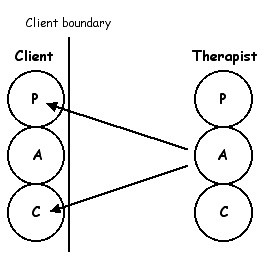A good deal of the usual counselling process involves presenting something to the client that may be new and then waiting for the client to do something with it. In this way it can be seen as a passive process.

This diagram shows how the therapist can present a variety of new or different actions, communications or relationship styles to the client. Once done the therapist then remains inactive to see what the client does with them, if anything. It is hoped that the client will take them and then alter something within their personality thus leading to psychological change. However as far a the therapist is concerned it remains as a hope. The therapist simply has to wait and see.
Two chair techniques allow the therapist to be more active. It allows the therapist to actually directly delve into the personality of the client. To get right into the personality of the client and change things around by stimulating various parts, highlighting them to the client and so forth. It also allows the therapist to establish relational contact directly with various aspects of the client’s personality.

This diagram shows that with the client’s permission the therapist can move beyond the exterior of the client’s personality and delve into the actual personality of the client using therapy processes such as two chair.
An important aspect of two chair is that the person does not take the role of the other party. If a client puts his mother in the other chair and then moves to be in mother’s chair he is not role playing mother. In that chair he is being the projection of his introjected mother. It is part of his personality in the chair not his memory of mother. In psychodrama one can role play other parties. In the two chair being described one is being part of their own personality in the other chair and not playing a role.
Two chairs techniques are also regressive techniques. It encourages the client to regress into their Child ego state from many years ago. This is a good thing as it provides a relatively easy way to get the Child ego state into the therapy room which should happen in most sessions. Generally speaking the focus of therapy is approximately:

Graffiti
No comments:
Post a Comment